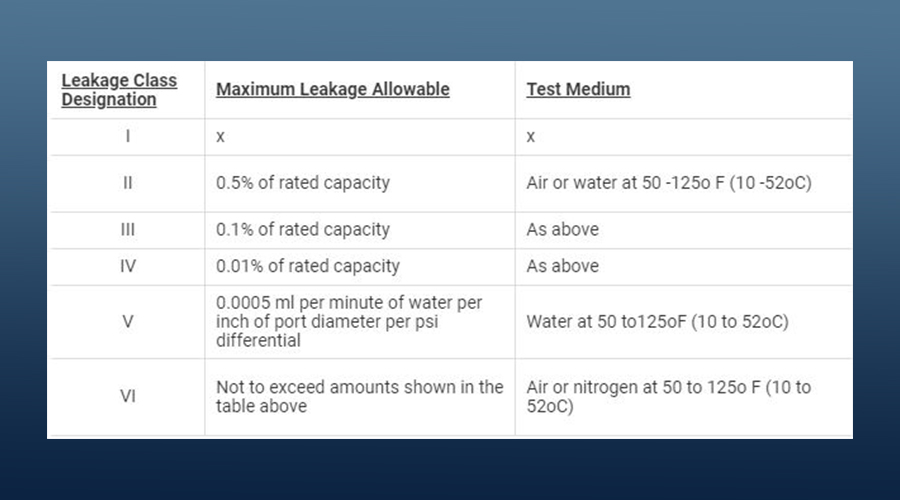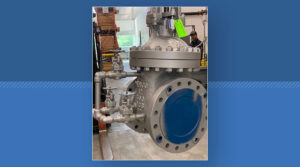
Class Seat Leakage
HYDRO TESTING – CLASS I to IVCLASS SEAT LEAKAGE
The term “Class” seat leakage comes from ANSI / FCI 70-2. This is a control valve seat leakage specification and does not apply to gates and globes used for on/off service. In ANSI / FCI 70-2, the forward states, “During the canvas of the 2003 version, one respondent asked for the standard to be modified to specifically exclude on/off valves for tight shut-off. The FCI Control Valve and Regulator Section notes that FCI 70-2 has been intended to apply to control valve seat leakage. If line isolation and/or absolute tight shut off is a normal expectation of the valve application, the FCI Control Valve and Regulator Sections recommend specifying another standard, such as API 598, ‘Valve Test and Inspection.’”
In FCI 70-2 section 4.2.5, the Class V leakage reads: “Class V. This class is usually specified for critical applications where the control valve may be required to be closed, without a blocking valve, for long periods of time with high differential pressure across the sealing surfaces. It requires special manufacturing assembly and testing techniques. This class is generally associated with metal seat, unbalanced single-port, single seat control valves or balanced single-port designs with exceptional seat and seal tightness.”
Gates and globes are not balanced or unbalanced in design, which would exclude them from meeting this description. The end user is specifying the incorrect test parameters for this type of valve if they wish to buy standard gates and globes. Newco/OIC valves are tested to API 598, which is the industry norm for this type of valve. If the customer wishes to specify additional restrictions on the allowable leakage rates, it should be specified as API 598 with their required allowable leakage rates given. If the customer’s allowable leakage rates are more stringent than API 598, then this would entail re-testing of the valves to ensure that these allowable leakage rates are met. This would incur additional charges. Listed below are the seat leakage Classifications. Classes I to IV are based on valve capacities. Gates and globes do not have rated capacities, therefore it is impossible to determine if they meet these allowable leakage requirements.
Valve Leakage Classifications
Class I – Valve Leakage Classifications Identical to Class II, III, and IV in construction and design intent, but no actual shoptest is made. Class I is also known as dust tight and can refer to metal or resilient seated valves.
Class II – Valve Leakage Classifications Intended for double port or balanced singe port valves with a metal piston ring seal and metal to metal seats.
• 0.5% leakage of full open valve capacity.
• Service dP or 50 psid (3.4 bar differential), whichever is lower at 50 to 125oF.
• Test medium air at 45 to 60 psig is the test fluid.Typical constructions:
• Balanced, single port, single graphite piston ring, metal seat, low seat load• Balanced, double port, metal seats, high seat load
Class III – Valve Leakage Classifications Intended for the same types of valves as in Class II.
• 0.1% leakage of full open valve capacity.• Service dP or 50 psid (3.4 bar differential), whichever is lower at 50 to 125oF.
• Test medium air at 45 to 60 psig is the test fluid.
• Balanced, double port, soft seats, low seat load
• Balanced, single port, single graphite piston ring, lapped metal seats, medium load
Class IV – Valve Leakage Classifications
Intended for single port and balanced single port valves with extra tight piston seals and metal to-metal seats.
• 0.01% leakage of full open valve capacity.
• Service dP or 50 psid (3.4 bar differential), whichever is lower at 50 to 125oF.
• Test medium air at 45 to 60 psig is the test fluid.
Typical constructions:
• Balanced, single port, Teflon piston ring, lapped metal seats, medium seatload
• Balanced, single port, multiple graphite piston rings, lapped metal seats
• Unbalanced, single port, lapped metal seats, medium seat load
• Class IV is also known as metal to metal
Class V – Valve Leakage Classifications
Intended for the same types of valves as Class IV.
• The test fluid is water at 100 psig or operating pressure.
• Leakage allowed is limited to 5 x 10 ml per minute per inch of orifice diameterper psi differential.
• Service dP at 50 to 125 oF.
Typical constructions:
• Unbalanced, single port, lapped metal seats, high seat load
• Balanced, single port, Teflon piston rings, soft seats, low seat load
• Unbalanced, single port, soft metal seats, high seat load
Class VI – Valve Leakage Classifications
Class VI is known as a soft seat classification.
Soft Seat Valves are those where the seat, shut-off disc or both are made from some kind of resilient material such as Teflon. Intended for resilient seating valves.
• The test fluid is air or nitrogen.
• Pressure is the lesser of 50 psig or operating pressure.
• The leakage limit depends on valve size and ranges from 0.15 to 6.75 ml per minute for valve sizes 1 through 8 inches.
| Leakage Class Designation | Maximum Leakage Allowable | Test Medium |
| I | x | x |
| II | 0.5% of rated capacity | Air or water at 50 -125o F (10 -52oC) |
| III | 0.1% of rated capacity | As above |
| IV | 0.01% of rated capacity | As above |
| V | 0.0005 ml per minute of water per inch of port diameter per psi differential | Water at 50 to125oF (10 to 52oC) |
| VI | Not to exceed amounts shown in the table above | Air or nitrogen at 50 to 125o F (10 to 52oC) |


